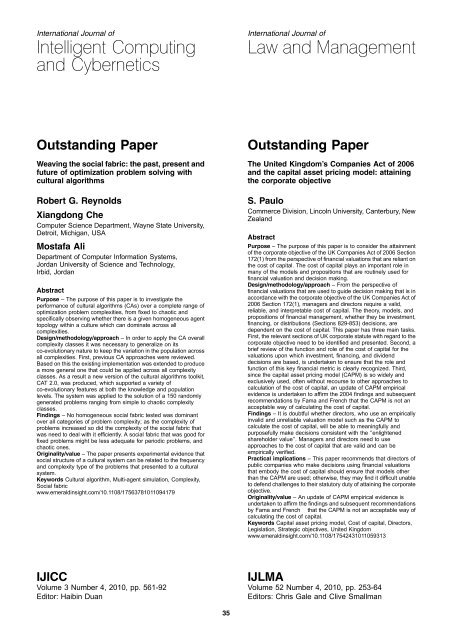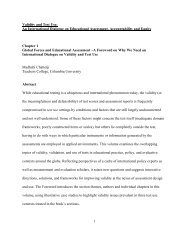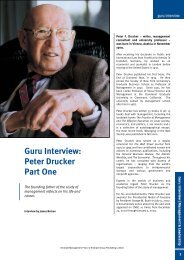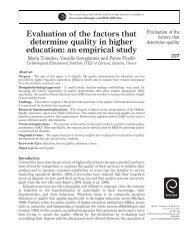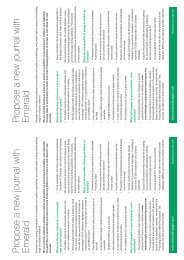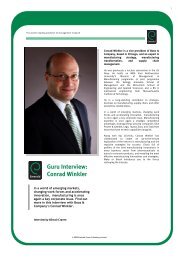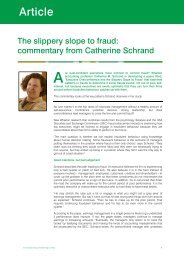Outstanding Paper - Emerald
Outstanding Paper - Emerald
Outstanding Paper - Emerald
You also want an ePaper? Increase the reach of your titles
YUMPU automatically turns print PDFs into web optimized ePapers that Google loves.
International Journal of<br />
Intelligent Computing<br />
and Cybernetics<br />
<strong>Outstanding</strong> <strong>Paper</strong><br />
Weaving the social fabric: the past, present and<br />
future of optimization problem solving with<br />
cultural algorithms<br />
Robert G. Reynolds<br />
Xiangdong Che<br />
Computer Science Department, Wayne State University,<br />
Detroit, Michigan, USA<br />
Mostafa Ali<br />
Department of Computer Information Systems,<br />
Jordan University of Science and Technology,<br />
Irbid, Jordan<br />
Abstract<br />
Purpose – The purpose of this paper is to investigate the<br />
performance of cultural algorithms (CAs) over a complete range of<br />
optimization problem complexities, from fixed to chaotic and<br />
specifically observing whether there is a given homogeneous agent<br />
topology within a culture which can dominate across all<br />
complexities.<br />
Design/methodology/approach – In order to apply the CA overall<br />
complexity classes it was necessary to generalize on its<br />
co-evolutionary nature to keep the variation in the population across<br />
all complexities. First, previous CA approaches were reviewed.<br />
Based on this the existing implementation was extended to produce<br />
a more general one that could be applied across all complexity<br />
classes. As a result a new version of the cultural algorithms toolkit,<br />
CAT 2.0, was produced, which supported a variety of<br />
co-evolutionary features at both the knowledge and population<br />
levels. The system was applied to the solution of a 150 randomly<br />
generated problems ranging from simple to chaotic complexity<br />
classes.<br />
Findings – No homogeneous social fabric tested was dominant<br />
over all categories of problem complexity; as the complexity of<br />
problems increased so did the complexity of the social fabric that<br />
was need to deal with it efficiently. A social fabric that was good for<br />
fixed problems might be less adequate for periodic problems, and<br />
chaotic ones.<br />
Originality/value – The paper presents experimental evidence that<br />
social structure of a cultural system can be related to the frequency<br />
and complexity type of the problems that presented to a cultural<br />
system.<br />
Keywords Cultural algorithm, Multi-agent simulation, Complexity,<br />
Social fabric<br />
www.emeraldinsight.com/10.1108/17563781011094179<br />
IJICC<br />
Volume 3 Number 4, 2010, pp. 561-92<br />
Editor: Haibin Duan<br />
35<br />
International Journal of<br />
Law and Management<br />
<strong>Outstanding</strong> <strong>Paper</strong><br />
The United Kingdom’s Companies Act of 2006<br />
and the capital asset pricing model: attaining<br />
the corporate objective<br />
S. Paulo<br />
Commerce Division, Lincoln University, Canterbury, New<br />
Zealand<br />
Abstract<br />
Purpose – The purpose of this paper is to consider the attainment<br />
of the corporate objective of the UK Companies Act of 2006 Section<br />
172(1) from the perspective of financial valuations that are reliant on<br />
the cost of capital. The cost of capital plays an important role in<br />
many of the models and propositions that are routinely used for<br />
financial valuation and decision making.<br />
Design/methodology/approach – From the perspective of<br />
financial valuations that are used to guide decision making that is in<br />
accordance with the corporate objective of the UK Companies Act of<br />
2006 Section 172(1), managers and directors require a valid,<br />
reliable, and interpretable cost of capital. The theory, models, and<br />
propositions of financial management, whether they be investment,<br />
financing, or distributions (Sections 829-853) decisions, are<br />
dependent on the cost of capital. This paper has three main tasks.<br />
First, the relevant sections of UK corporate statute with regard to the<br />
corporate objective need to be identified and presented. Second, a<br />
brief review of the function and role of the cost of capital for the<br />
valuations upon which investment, financing, and dividend<br />
decisions are based, is undertaken to ensure that the role and<br />
function of this key financial metric is clearly recognized. Third,<br />
since the capital asset pricing model (CAPM) is so widely and<br />
exclusively used, often without recourse to other approaches to<br />
calculation of the cost of capital, an update of CAPM empirical<br />
evidence is undertaken to affirm the 2004 findings and subsequent<br />
recommendations by Fama and French that the CAPM is not an<br />
acceptable way of calculating the cost of capital.<br />
Findings – It is doubtful whether directors, who use an empirically<br />
invalid and unreliable valuation model such as the CAPM to<br />
calculate the cost of capital, will be able to meaningfully and<br />
purposefully make decisions consistent with the ‘‘enlightened<br />
shareholder value’’. Managers and directors need to use<br />
approaches to the cost of capital that are valid and can be<br />
empirically verified.<br />
Practical implications – This paper recommends that directors of<br />
public companies who make decisions using financial valuations<br />
that embody the cost of capital should ensure that models other<br />
than the CAPM are used; otherwise, they may find it difficult unable<br />
to defend challenges to their statutory duty of attaining the corporate<br />
objective.<br />
Originality/value – An update of CAPM empirical evidence is<br />
undertaken to affirm the findings and subsequent recommendations<br />
by Fama and French that the CAPM is not an acceptable way of<br />
calculating the cost of capital.<br />
Keywords Capital asset pricing model, Cost of capital, Directors,<br />
Legislation, Strategic objectives, United Kingdom<br />
www.emeraldinsight.com/10.1108/17542431011059313<br />
IJLMA<br />
Volume 52 Number 4, 2010, pp. 253-64<br />
Editors: Chris Gale and Clive Smallman


